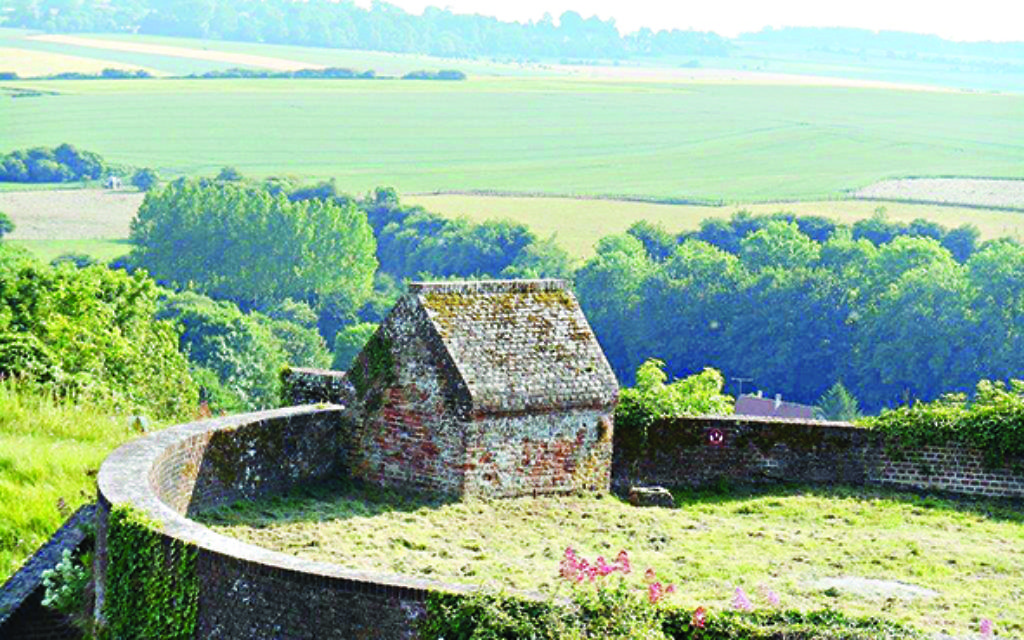Northern France’s memories of the fallen
Visiting northern France, Lucy Daltroff finds poignant reminders of the casualties of conflict 100 years ago
It’s a large area with rows and rows of immaculately-tended white headstones grouped together in pairs. Red roses and shrubs grow in the flower beds. It’s sad, but strangely beautiful. I am in Étaples Military Cemetery, designed by Sir Edwin Lutyens and the largest Commonwealth War Graves Commission cemetery in France.
Lying before me are the last resting places of 10,773 casualties from the First World War, all of whom died in the 20 hospitals built in this area. To the left of the main plot is a segment where the tombstones are set more widely apart. Closer inspection reveals it as the Jewish section, containing 24 stone markers.
Get The Jewish News Daily Edition by email and never miss our top stories Free Sign Up

Each bears the name of the regiment of the dead soldier, a Magen David and the date of death. Some have family messages on the bases. Air mechanic Aaron Levy’s reads: “In loving memory of our dear son. May his soul rest in peace”.
This is a poignant beginning for my tour of the area between Ypres and the Somme in the Pays de Calais region of France, and its associations with the conflict of 1914-18.
Just seven miles down the road from Étaples is an attractive cobbled square that is the centre of Montreuil-sur-Mer. In medieval times, the town was an important fortified port. Its defences were strengthened in 1567 under French king Charles IX, who also added a citadel. Then, in the 1670s, Vauban, the famous French military engineer, built on top of the fortifications to make them even stronger.
It was this infrastructure that became an important factor when the British headquarters commanded by General Haig moved here in 1916. It made sense geographically too, as the various British bases on French soil were within easy reach. It was near the front line and halfway between the Allied capitals of London and Paris. Suddenly, peaceful Montreuil became the military capital of the First World War.
The citadel today contains a small but informative war museum. The red bricks and attractive architecture have great charm and I soon found that walking on the ramparts gives a fine view over the surrounding countryside.
Victor Hugo spent just a few hours here in 1837, yet immortalised it by using the town as the setting for Les Misérables. To commemorate this, every year, a themed outdoor son et lumière spectacle is staged at the foot of the ramparts, with hundreds of locals taking part.
It is an attractive town, with many of the houses in the cobbled streets bearing brightly-coloured flowers trailing from their window boxes. There are also several small hotels and eateries. For a real treat, try dining at the Chateau de Montreuil, a Michelin-starred restaurant noted for its food and stylish surroundings.
Returning to memories of the war, I find – in stark contrast to the ancient walls of the citadel – the imposing white Canadian Memorial, a tribute to the 11,285 Canadian soldiers reported missing during the First World War. Many were lost on 9 April 1917 in the battle of Arras when they succeeded in taking Vimy Ridge, which had been strongly defended by the German army.

In the front of the tall cenotaph is a powerful statue depicting Mother Canada mourning her lost sons. The memorial took the designer, Walter Seymour Allward, 11 years to build and was unveiled by King Edward VIII on 26 July 1936. The whole dramatic appearance is further enhanced by its setting – in the middle of a 250-acre preserved battlefield park.
Another casualty of the conflict was the famous artist and war poet Isaac Rosenberg, who died at dawn on 1 April 1918. In contrast to other celebrated war poets, Rosenberg was a private. His Poems from the Trenches are recognised as some of the most exceptional written during the First World War and his artistic talents are shown by very visual depictions in his poems.
Rosenberg was assigned to the 12th Battalion of the Suffolk Regiment, a bantam battalion for men under the usual minimum height of 5ft 3in. After turning down an offer to become a lance corporal, he was later transferred to another bantam battalion, the 11th Service Battalion of the King’s Own Royal Lancaster Regiment. In June 1916, he was sent with his battalion to serve on the Western Front in France and continued to write poetry while serving in the trenches.
No one knows whether his death occurred at the hands of a sniper or in close combat, but he died in a town called Fampoux, north-east of Arras, at the age of 27. His simple grave is at Bailleul Road East Cemetery, Plot V, Saint-Laurent-Blangy. Later, he was honoured in Poet’s Corner in Westminster Abbey and his self-portraits displayed in both the National Gallery and Tate Britain.
• Useful Contacts
Pas de Calais Tourism: www.uk.pas-de-calais.com
Lucy travelled with P & O Ferries: www.poferries.com
The Citadel: www.tourisme-montreuillois.com or www.chateaudemontreuil.com
Lucy stayed at the Best Western Hotel Hermitage: www.hermitage-montreuil.com
Holiday Inn Express Arras: www.holidayinn-arras.com

Thank you for helping to make Jewish News the leading source of news and opinion for the UK Jewish community. Today we're asking for your invaluable help to continue putting our community first in everything we do.
For as little as £5 a month you can help sustain the vital work we do in celebrating and standing up for Jewish life in Britain.
Jewish News holds our community together and keeps us connected. Like a synagogue, it’s where people turn to feel part of something bigger. It also proudly shows the rest of Britain the vibrancy and rich culture of modern Jewish life.
You can make a quick and easy one-off or monthly contribution of £5, £10, £20 or any other sum you’re comfortable with.
100% of your donation will help us continue celebrating our community, in all its dynamic diversity...
Engaging
Being a community platform means so much more than producing a newspaper and website. One of our proudest roles is media partnering with our invaluable charities to amplify the outstanding work they do to help us all.
Celebrating
There’s no shortage of oys in the world but Jewish News takes every opportunity to celebrate the joys too, through projects like Night of Heroes, 40 Under 40 and other compelling countdowns that make the community kvell with pride.
Pioneering
In the first collaboration between media outlets from different faiths, Jewish News worked with British Muslim TV and Church Times to produce a list of young activists leading the way on interfaith understanding.
Campaigning
Royal Mail issued a stamp honouring Holocaust hero Sir Nicholas Winton after a Jewish News campaign attracted more than 100,000 backers. Jewish Newsalso produces special editions of the paper highlighting pressing issues including mental health and Holocaust remembrance.
Easy access
In an age when news is readily accessible, Jewish News provides high-quality content free online and offline, removing any financial barriers to connecting people.
Voice of our community to wider society
The Jewish News team regularly appears on TV, radio and on the pages of the national press to comment on stories about the Jewish community. Easy access to the paper on the streets of London also means Jewish News provides an invaluable window into the community for the country at large.
We hope you agree all this is worth preserving.
-
By Brigit Grant
-
By Laurent Vaughan - Senior Associate (Bishop & Sewell Solicitors)
-
By Laurent Vaughan - Senior Associate (Bishop & Sewell Solicitors)
-
By Laurent Vaughan - Senior Associate (Bishop & Sewell Solicitors)
-
By Laurent Vaughan - Senior Associate (Bishop & Sewell Solicitors)






















